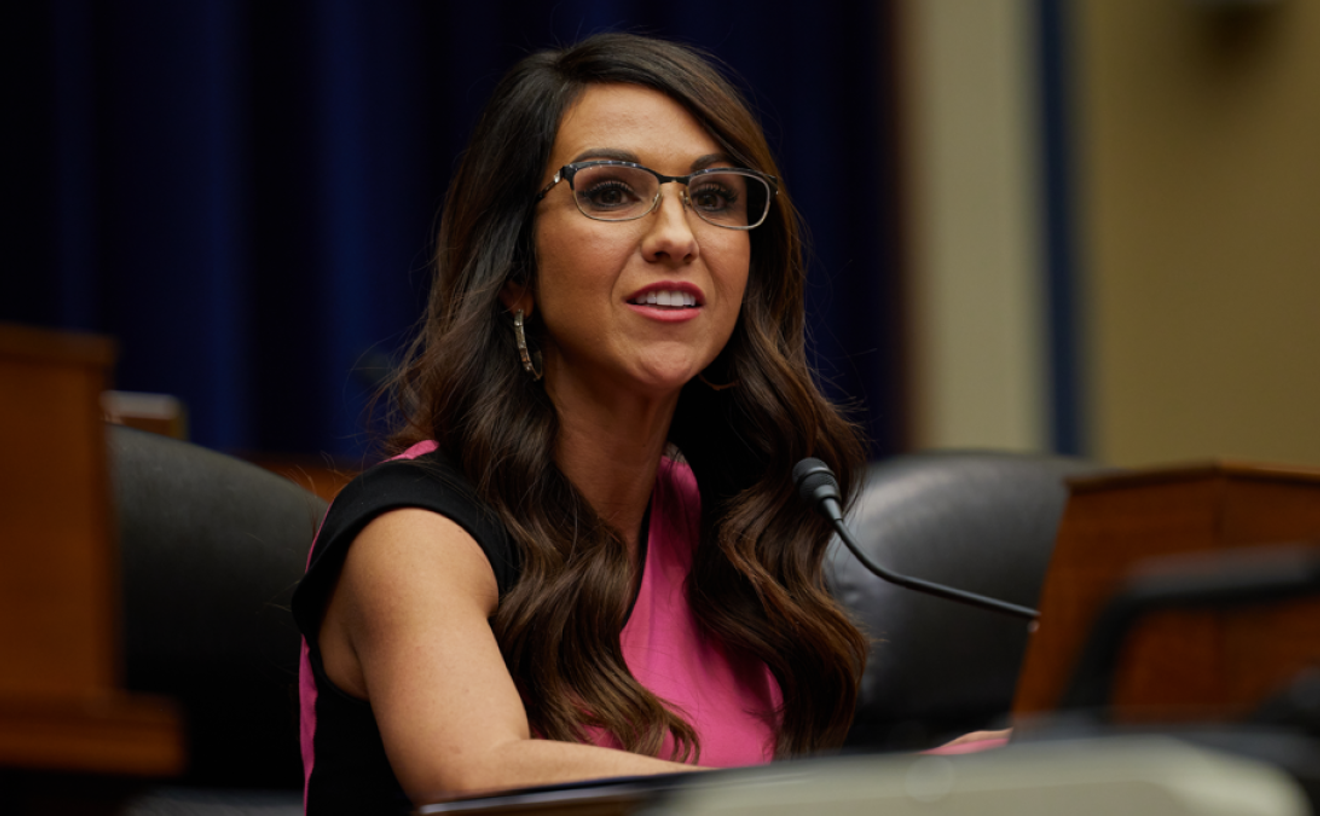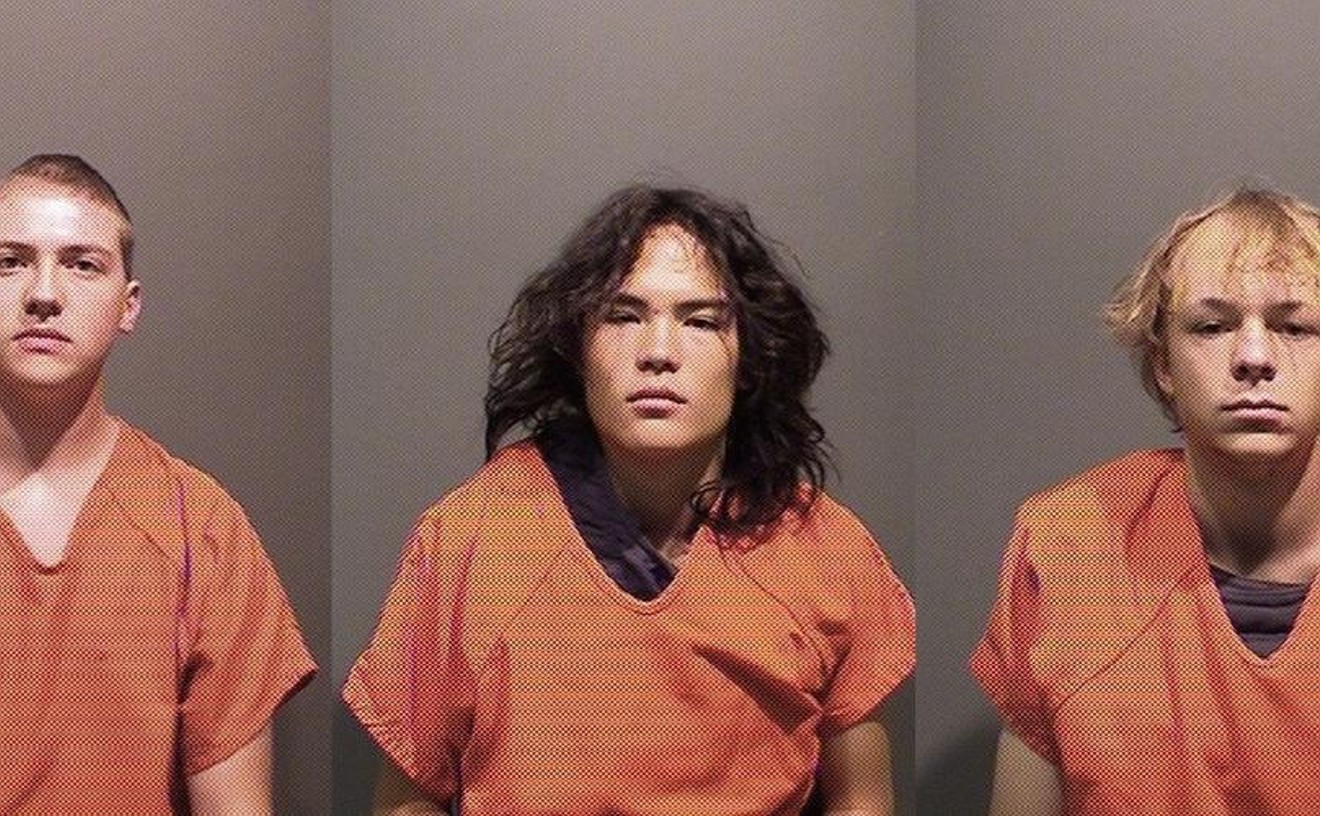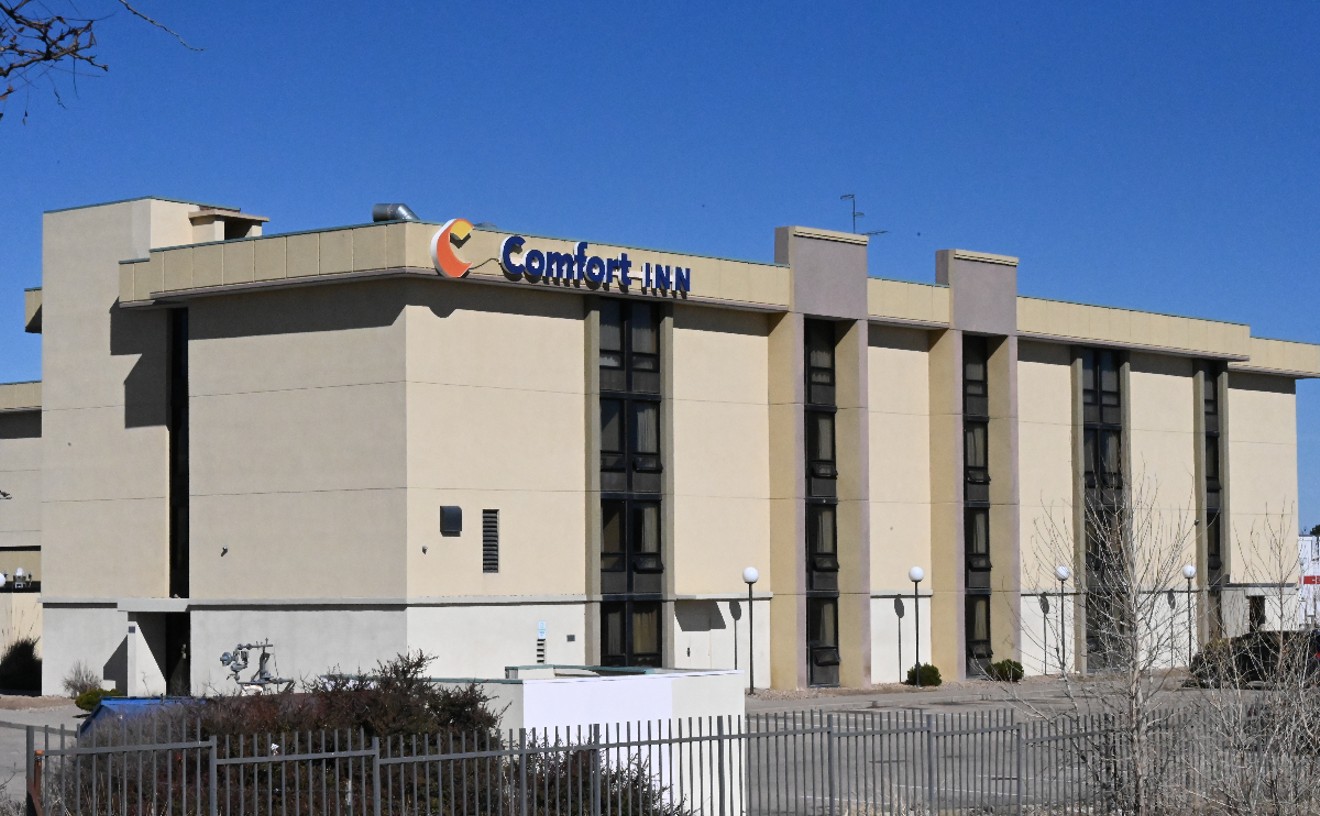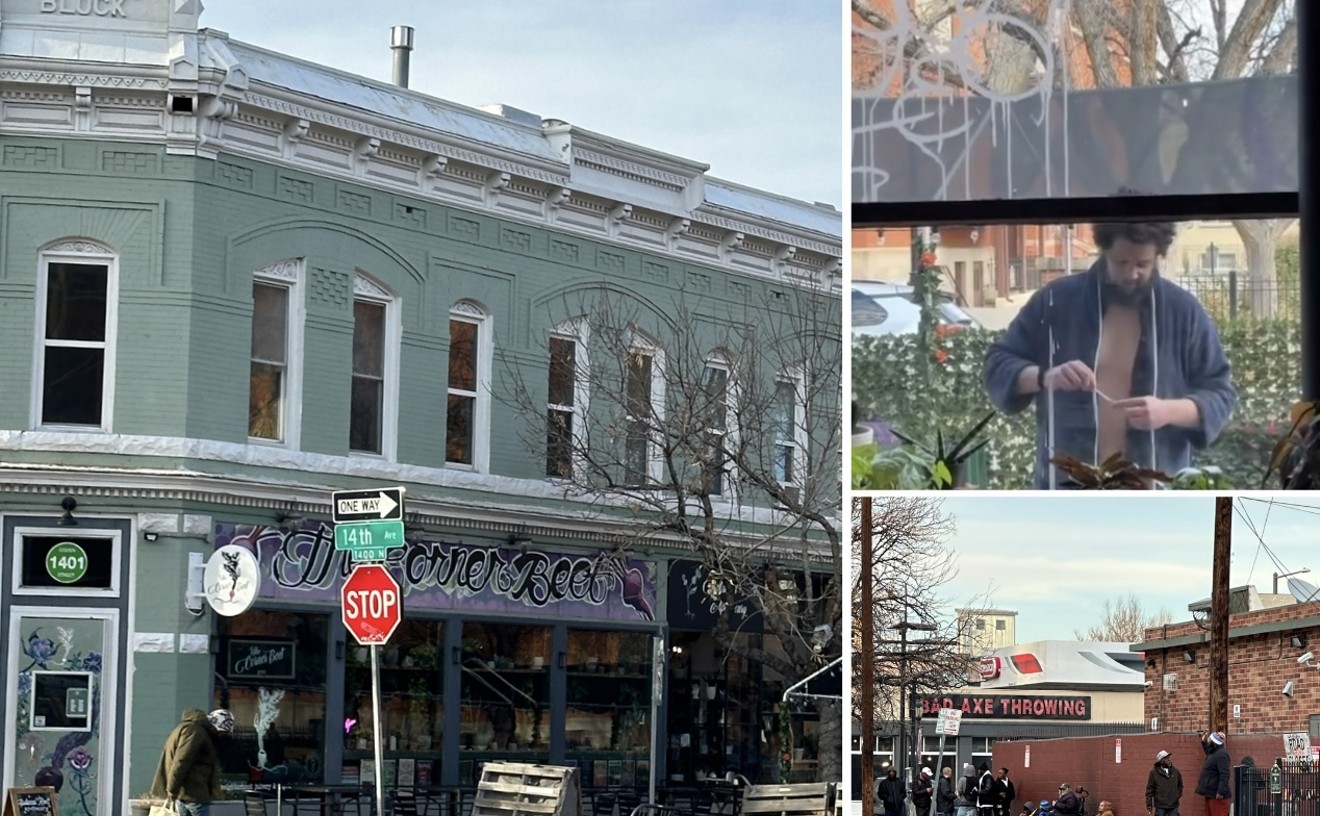It was the fourth time Fiolkoski had seen death on the tracks, and the kids killed at Titan Road brought the number of fatalities he'd witnessed to an astonishing nine. In all of those accidents, Fiolkoski had escaped physical injury, but the deadly collisions still had penetrated the safety of his engine's thick metal walls. "My wife said she could see the effects after this one," Fiolkoski says. "It triggered a whole bunch of stuff in me, really busted me up. I almost went off the deep end. Titan Road still affects me."
George Last, another local train engineer, understands. "I was driving across Nebraska," Last recalls in deliberate sentences. "I hit a pickup truck. With a family in it." Then a newcomer to his job, he'd heard of such moments from his older peers but was hardly ready for the grim scenario. After bringing his train to a halt, Last took a long, anxious walk back up the moonlit tracks. Five corpses--two young parents and their three small children--lay scattered about their mangled vehicle, killed on impact with Last's train. Twenty-five years later, he says, "I still have flashbacks and strange dreams about it sometimes. It just reappears over and over again."
So far this year in Colorado, two people have died in train incidents; that number already equals last year's death toll. On New Year's Day, a Colorado Springs man stretched himself across steel rails to end his life, staring down the train's helpless conductor as the engine crushed his torso. In a railyard in Commerce City a few weeks ago, a man lost his life in a failed attempt to hop a moving freight. "We found about 495 feet of him scattered down the yard," says a security guard.
The National Transportation Safety Board reports that somewhere along the 172,500 miles of rail in the United States, a train collides with a vehicle or a human about once every 100 minutes. In 1998 trains and vehicles clashed 3,446 times, and there were 979 fatalities on America's rails--more than in an average year's worth of plane crashes in the U.S.
Even light-rail engineers are not immune to the possibility of killing someone. Since its inception in 1994, RTD light-rail trains have been involved in 123 accidents, most of them involving collisions with cars, two of them fatal. In October 1994, a man who appeared to be drunk walked out in front of a light-rail train at 15th and California and was killed. In August 1996, a motorist drove around stopped cars and through the crossing gates at 13th and Pecos. A light-rail train hit the car, killing the person on the passenger side.
According to the Brotherhood of Locomotive Engineers, a driver who's been at the switch for ten years is statistically assured of being involved in at least one fatal crash. Many drivers, like Fiolkoski, have experienced a much higher number, and their experiences sound like campfire horror stories. In Denver a man lies down before an oncoming train to end his life but changes his mind at the last moment. When he fails to scurry off the tracks in time, he loses both arms and both legs to the wheels of the train. The mutilated victim lies among his limbs, reciting the Lord's Prayer to the stunned engineer who attempts, somehow, to comfort him (the man lives). Another driver recounts the sight of a car full of people pinned to the front of his skidding engine, their faces white with the knowledge of impending death. An instant later, the engine's nose punctures the car's shell and crushes its occupants.
Whether it's the March 15 Amtrak collision near Chicago that left eleven dead or the October 5, 1998, suicide of David Letterman stalker Margaret Ray on Union Pacific tracks hear Hotchkiss, train drivers say the tally of victims is always off by at least two. "There's the person who gets hit," says Rich Dooley, a local engineer who's been operating trains for 22 years, "and there's the crew on the train."
"These men are unwilling participants in a horrific thing," says Dane Freshour, a counselor who works with Burlington Northern Santa Fe drivers involved in train accidents. "It's very gruesome when you look at the aftermath--the body parts, the blood. It's very traumatic." Flashbacks, including visual images and returning smells from the scene of the accident, are a frequent problem, along with fatigue, depression, sleeplessness and a sense of constant frustration over what happened. Occasionally, these effects are enough to prevent engineers and conductors from returning to their jobs, but such psychological stresses have been a part of train culture since its beginning, Freshour says. In the 1800s, engineers suffered "railway brain" and "railway spine"--what psychologists now call post-traumatic stress disorder. "Our awareness has improved a lot after the World Wars and Vietnam, when we saw combat veterans come back from dealing with traumatic experiences and exposure to situations outside the usual realm of human experience," Freshour says.
Several factors contribute to the severity of an engineer's PTSD. The age of the victim is always a major factor, especially if it's a child and the driver has children of his own. The number of fatalities also plays a role. "I've had clients who've had six, seven, eight experiences like this," Freshour says, "and there's a cumulative effect that makes it worse. But if we get them the right support and respond appropriately, hopefully we're able to salvage a man's life and career. That's our goal."
Freight-train drivers involved in crashes are met within a few hours of an incident by peer counselors, co-workers who have been involved in similar situations. Within 24 hours of the crash, they are "diffused" by a psychologist, who leads the driver through a retelling of the accident. "We know that the best treatment for any critical incident is for the person to revisit the incident," says Tom Scarano, a Denver psychologist who counsels drivers for Union Pacific and BNSF. "One of the major themes we deal with is the issue of personal responsibility," he notes. "No matter how irrational it seems, most people think that they could have somehow prevented what happened. It's amazing."
Scarano has been working with train operators since 1985; every year, he gives critical incident counseling to around fifty patients. He says most of them are able to return to their jobs within a few days, albeit with lingering emotional burdens that may stay with them for years.
In the past, drivers involved in crashes were given a different type of therapy: After the bodies and wreckage were cleared from the track, crews were told to get back in their engines and finish their routes. Starting around 1990, however, railroads began sending relief crews to finish the train's route and giving its crew members up to three days off with pay and counseling. These changes in policy are welcome, Dooley says. "People think we're all tough old guys at the throttle, but nobody's that tough. If he is, he's got a cold steel heart. Or he's been in too many [accidents]. Some of these guys have been out in the yard and come across a guy who has been cut in half trying to hop a train. It used to be you just sucked it up and you'd go on. But that doesn't work. It causes problems."
During one run through Sedalia, a truck driver raced through a crossing in front of Dooley's train, resulting in a collision. The driver suffered a deep gash to his head, and Dooley, a trained first-aid technician, helped save the man's life by holding his brains in his skull while waiting for emergency crews to arrive. The man survived, but another man was less lucky. A couple of years ago, a Colorado Springs man ended a fight with his spouse with a promise to kill himself. He chose Dooley's train to carry out the pledge. As Dooley's train rode out on a bridge near the Garden of the Gods, the man jumped out of the darkness and into the path of Dooley's train.
"I heard a thump," he recalls, "and as I looked in the rearview mirror and applied the brakes, I could see him flopping along the railing, bouncing off the engines. He just kind of cartwheeled along the bridge. It killed him. Turned him into Jell-O inside. He was already cooling off by the time we got back to him." Following such incidents, Dooley says, "you're stunned, and you get a feeling of helplessness, of what could I have done to have prevented this from happening? You're always second-guessing yourself, wondering if you should have been looking out better. And all of these things are fallacies."
Train crews say suicides are a recurring dilemma for them. "But people don't realize the pain and the heartache that they cause when they lay down on those tracks," says one engineer. "They have no idea. You're driving that train, and all of a sudden somebody jumps out between the rails. Well, you're the last person to see another human alive. They're standing there in front of you; you see their faces and the whites of their eyes looking up at you. The emotional impact is too much...But what can you do?
"You take that Margaret Ray," the engineer adds. "Someone like that looks at the train and thinks it's some big piece of machinery that runs itself. But there are human beings inside of it, with emotions and families. If these people want to end their lives, why don't they go up on some cliff and jump? Keep me out of it."
Some engineers say law-enforcement officers untrained in how to investigate suicides and crashes add to their troubles. Many engineers complain of inexperienced police officers who arrive on the scene, brand the train conductor a homicide suspect, demand his driver's license and registration as if he'd been driving a car, and refuse to keep his name off any accident report. "Somebody gets ahold of that," a Denver engineer says, "and here comes the guy's relatives wanting to crucify you. You get calls in the middle of the night: 'Murderer! Killer! You killed my son. You killed my brother.' I don't need that. My wife doesn't need that."
"That has been a longstanding problem with the way police officers approach train investigations," says Craig LeVere, a sergeant with the Colorado State Patrol. "What we're training officers to do now is consider these train men victims." Law-enforcement officers now attend courses taught in conjunction with Operation Lifesaver, a national organization that works to educate drivers on the risks of contact with trains. The courses are designed to teach officers the unique requirements for dealing with train accidents. LeVere, who teaches some of the classes, says they are eye-openers for his peers.
The courses often involve officers taking a train ride so they can see things from an engineer's perspective. Much of the course involves changing old, highway-based policies. Instead of asking for a conductor's automobile license and registration, police now ask for engineering licenses and company identification. And while the names of crew members cannot be kept from a police report, officers use work numbers and addresses for contact information, reducing the chances of a survivor contacting the train crew. Cops are also taught how to properly conduct an investigation of a train accident, which can be crucial in later court cases. LeVere says crash survivors sometimes sue for damages from rail companies, even when those victims were clearly at fault. "I've been involved in some of these cases," he says, "and that's been frustrating for me. A guy doesn't stop at a stop sign and his wife gets killed, but now he's suing the railroad when he didn't do what he's supposed to do."
And more people are doing what they're not supposed to do. Population growth along the Front Range has increased the number of people trespassing on Colorado tracks--everyone from urban and suburban residents using tracks as walking paths to recreationists taking advantage of rails and tunnels as shortcuts to better hunting, fishing, hiking and kayaking. "That kind of activity is on the rise," says Eric Sondeen, a Littleton firefighter who volunteers as the state coordinator for Operation Lifesaver. "We're seeing a tremendous population increase in both our full-time population and our visitor population, and these people are putting themselves in harm's way."
Engineers say the Tunnel District, the region that stretches from the foothills west of Rocky Flats up through Eldorado Canyon and Winter Park, is a frequent site for Lycra-clad outdoor types to risk life and limb. Sondeen says the public's misconception that rail traffic is down may be leading people to hike along tracks and through tunnels. "There are more trains running more miles and carrying greater capacities than ever before," he points out. "The myth is 'There probably won't be a train here,' but the reality is 'There probably will be a train here.' What we're stressing is that people should always expect a train, at any time, in any direction and on any track."
In 1998, over half of the deaths on America's tracks were those of individuals illegally on rail-company property. In addition to clueless hikers, there's the problem of freight-hoppers. The majority of people who try to jump onto moving trains are, like Depression-era hobos, trying to catch free rides south in the winter, but when the weather warms up, railyard security guards see an increased number of "yuppie freight-hoppers"--misguided men who consider the activity a type of romantic, mythological sport. People who hang out in railyards for other reasons--photographers looking for artistic shots, for example--are killed by trains being moved about on the railyard tracks. They often have no warning, since today's welded-steel rails have eliminated the rhythmic track rattle of days past. Rail companies are doing their best to hold down the growing number of potential victims: Nationwide, Union Pacific reports, "trespasser evictions" increased from 42,800 in 1997 to 48,099 in 1998.
Even when trespassers escape injury or death on a train track, Sondeen says, these close calls are potentially deadly for a train crew. "The engineer doesn't know you're safe or if you're going to step off the track, and he has to make the decision of whether to put the train into emergency and put themselves and their load in jeopardy. And they need to make that decision a mile from where they see the individual on the track." Anyone willing to risk contact with a train, he notes, "is making a bad risks-to-benefits analysis."
The foolish behavior engineers witness daily is a source of constant frustration and potential danger. For starters, drivers fail to understand the optical illusion created by a train racing down a track. The train appears to be moving slowly, giving drivers a false impression that they have time to beat it through a crossing. They say the public is also unaware of the lengthy stopping distances trains require, distances that can reach up to a mile and a half for a loaded, 100-plus freight train or a high-speed passenger train. Especially frustrating for train crews is the fact that more than half of all train collisions with cars and trucks occur during daylight hours, at crossings where flashing lights and crossing gates are in place. More puzzling, a quarter of all train-car collisions involve a car running into a train that's already in the crossing.
"I don't know how to explain it," says Sondeen. "It's beyond me. The reason I'm in Operation Lifesaver is because if I can help people understand it, I'd rather do that than have to respond to a 911 call after the fact. There's not much I can do at that point." Sondeen leads a staff of local volunteers, most of them engineers and conductors, who teach courses in rail safety to schools, police departments and other interested groups.
But such educational efforts are lost when people simply act like idiots. "As our population has boomed, drivers are using their cars as time machines rather than transport vehicles, and we're getting in trouble with that," Sondeen says. "People are not using caution around crossings, and 'road rage' translates directly into people's behavior around crossings: People aren't willing to take the time to wait."
In an attempt to limit the opportunities for impatient drivers to kill themselves, federal and state officials are reducing the number of public rail crossings. In 1991 the U.S. Department of Transportation pledged to cut the number of crossings by 25 percent before the year 2001; since then, the number of crossings has been reduced by more than 33,000. Between 1996 and 1997, Colorado cut the number of statewide crossings from 3,623 to 3,270.
For freight haulers, dumb drivers are a constant source of trouble. "We have certain crossings where we know people are gonna try to beat us," says J.J. Witt, staring out the window of his engine as it rolls across the countryside south of Castle Rock. "People just don't care," he says. "If you're going to delay them a minute or two while the train goes by, that's worth risking their life for. When it first happens, it's kind of surreal. You sit there and think, 'I can't believe somebody was stupid enough to go out in front of us like that.' But to the public, we're always at fault. 'That damn train ran right into that car.'"
Witt is joined in the sleek cabin of his brand-new SV Mack 70 engine by conductor Ken Masias and student engineer Steve Mullins. Masias sits on the left of the cab, eyeing a digital speedometer and a folder of log sheets before him. Mullins, a two-year trainee and the son of a retired engineer, sits in a captain's chair on the right, piloting the engine as Witt supervises. The three men have been rolling since 6:30 in the morning, traveling north from Pueblo to Denver. Mullins works the lever controlling the train's speed, brakes and direction of travel. A small computer screen in front of him displays the engine's vitals. Behind him, 3,100 tons and 6,486 feet of train snake across a sun-kissed landscape.
To Mullins's right is the train's emergency brake. He hasn't had to engage it today, but if he does, the men know what to expect. Mullins will shift the lever into place, the train's brakes will lock up, and 118 empty coal cars will lurch forward and gobble up the slack in their couplings. A battleship's worth of steel and machinery will slam into a skid, and as the wheels dig down on the tracks, the crew will reach for a handhold and await an impact with whatever's in their path. Witt has had to "plug it" before in several close calls, six collisions and a suicide.
"I hit a car once," he recalls of a 1981 incident in his home state of Texas. "The crossing gates were down, cars stopped on both of the crossing gates. Three college girls drove up and flew by all these cars through the gates." He pauses a moment to spit the shells of a sunflower seed into a plastic bottle. "The driver was killed, the girl in the backseat was killed. We went to get 'em out, and the passenger in front, she was hysterical, screaming, 'Don't kill me, don't kill me.' The other two still had the champagne glasses in their hands that they'd left the bar with. You remember every detail of something like that."
A quarter-mile from the first of a series of crossings, Mullins sounds the engine's whistles in accordance with federal rail laws. As the train continues, a computer-generated voice comes across the cabin radio and acknowledges that all of the train's equipment is working properly. Up ahead, gates drop at the crossing and a pair of signal lights facing the train shine green. "If we derail, that guy's dead," Witt says, nodding toward a car that has inched over the crossing marks on the pavement. After the train travels a few more miles and quietly slips past the town's outlet shops, a cement mixer rolls up to another intersection as warning lights flash and the train whistle bellows. But instead of stopping, the truck driver hits the gas, bouncing across the tracks, framed in the green lights indicating to the crew that the track is clear. As the truck rumbles hurriedly over the rails, the crossing gate drops within a few inches of its mixer. "Look at that guy," Witt grumbles, shaking his head. "I've seen trucks tear the gates right off.
He's seen countless other vehicles--trucks, cars, school buses--take a similar gamble. "We supposedly have a program where if you get the license plates, you can turn it in and they'll ticket the driver," Witt says, but only one of the ten plate numbers he's turned in has ever been given a summons. Law-enforcement officials, he says, don't consider stopping rail trespassers an important endeavor. "It's not a serious enough situation until you actually run over somebody. Then it's serious."
Witt and Masias were the backup crew for the Titan Road accident, and the crash site borders Burlington Northern's Big Lift Station at Titan Road and Highway 85. After the crew makes a quick stop at Big Lift, Mullins eases his train of empty coal cars across Titan Road while idling motorists wait for the train to pass. Just outside Mullins's window, a series of stones placed in primitive fashion in the dirt beside the track spell out six names, weathered memorials to the six teens who perished here four years ago. A few of the stones have tumbled from their places to rest among the scraps of six broken wooden crosses below. "You start playing tag with a train, you're gonna lose," Masias says. "The public needs to understand that."
Witt interrupts: "Ah, but Kenny, they know better, and they still do it. They've obviously never seen a car hit by a train."
Today Larry Fiolkoski still runs a route across Titan Road, and he says drivers there continue to gamble with death when the train approaches. "I see people run this crossing all the time," he says. "All the time. Everyone thinks, 'It won't happen to me; it'll happen to someone else.' And everybody's in a hurry to go nowhere and do nothing when they get there. So what's the hurry at a crossing? I get tired of it, how stupid people can be.










